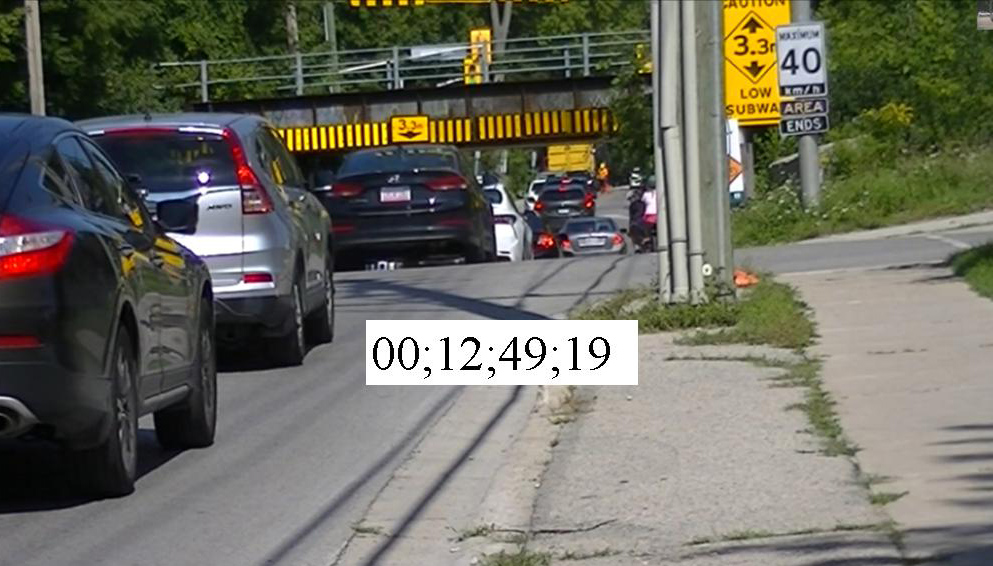Gorski Consulting has been following the repercussions of a decision by the City of London Ontario to create a detour route around some construction that was being done on the Thames Valley Parkway (TVP) in an area just north-west of the downtown of the City. The TVP is a popular, multi-use, pathway that generally follows the three-pronged Thames River in London.
In an earlier article we described how the detour contained three area of concern (See map below): 1.) a left turn at Talbot and Ann streets, 2.) a passage through the narrow underpass of the CPR railway crossing on Talbot south of Oxford Street, and 3.) the passage of cyclists down a steep downslope of Grosvenor Street at Gibbons Park. Cyclists who attempted to follow the designated detour met up with obstacles that could have caused collisions, injuries and/or worse. Each of these dangers is highlighted in individual articles.

In an article entitled “Following The Chaos of A Detour – Part 1” we focused on the first danger: The left turn of cyclists from Ann Street onto Talbot. The actions of 21 cyclists who were eastbound on Ann Street and made a left turn onto northbound Talbot Street were described.
The current article will focus on the second danger encountered when cyclists attempted to pass through the narrow opening of the CPR underpass on Talbot Street just south of Oxford Street.
Passage of Cyclists Through The Narrow CPR Rail Underpass
In analysis of video from August 24, 2022, 21 cyclists were observed eastbound on Ann Street and making a left turn onto northbound Talbot Street. Of those 21, 10 cyclists never crossed Talbot Street in the expected manner. Instead these ten cyclists opted to turn northbound onto the west sidewalk of Talbot, presumably because they determined it was either unsafe or too difficult to cross Talbot Street. This decision might have been reasonable if the west sidewalk of Talbot continued underneath and past the CPR underpass. But that was not the case. The west sidewalk ended at the underpass. And this caused a dilemma that these cyclists had not expected. The video provided a clear indication of the difficulty they experienced during this revelation.
Rather than describing the actions of all 10 cyclists, we have chosen only two examples. If the actions of all 10 cyclists were displayed in this article it would make for a long description with a large number of figures. Yet the two examples provide a reasonable summary of the actions of all ten.
Example #1
In the first example we focus on an adult male accompanied by a young female, likely of pre-teen age. The male led the child eastbound along Ann Street and then northbound on Talbot Street. Reconsiderations had to be made and the riders backtracked as shown in the map below. The details of their actions are also summarized in the following text:
Come to stop at timecode 00;08;15;00 at Talbot Street on south sidewalk of Ann Street next to pedestrian crossing button. Does not press button. Waits for couple of minutes. Begin crossing Ann St NB at 00;09;55;00 toward CPR underpass. Begins riding NB along W sidewalk of Talbot. Stops at Piccadilly St. Then continues NB past Piccadilly toward CPR underpass. Stop before reaching underpass. Discussion between male and female. Both riders dismount get back on bikes and return southbound crossing Piccadilly at 00;11;33;40. Return to Ann St at 00;11;57;00. Wait again on Ann St then cross Talbot at @00;12;15;00 via pedestrian crossing. Begin riding northbound along east sidewalk of Talbot and continue through CPR underpass.














In total it has taken the two cyclists over 4 and 1/2 minutes delay to pass through the CPR underpass from their first approach to the intersection of Ann and Talbot Streets. There could have been instances where they might have attempted to cross Talbot Street where crossing could have been precarious and this is a result of the City of London guiding them to take this detour.
Next we have a second example of another cyclist who chose not to cross Talbot Street when he first arrived from eastbound Ann Street. Again, the cyclist chose to travel northbound along the west sidewalk of Talbot and he also encountered the problem that the sidewalk ended at the CPR underpass. His decision to deal with this problem was unexpected, as will be shown in the video frames shown below.
Example #2
First we can see the male cyclist travelling eastbound on Ann Street and approaching the stop sign at Talbot Street, as shown in the first frame below.









Discussion
The male cyclist in the second example shows how cyclists will invent ways of achieving their goals through unorthodox ways. But this dangerous action was influenced by the advice given by the City of London to use the detour that created the cyclist’s difficulties. In the vast majority of instances there are no serious consequences in these actions. Just like in many instances of alcohol impairment, speeding, many drivers avoid detection, collisions, injuries, etc. Poorly maintained roadways or defective vehicles also escape detection for many occasions before a tragic event occurs and the problem is uncovered.
Through video observations of cyclists passing through this detour we can uncover deficiencies that could be corrected before a tragedy occurs. But this requires serious attention to these dangers by those officials whose responsibility it is to keep our roadways safe.
You must be logged in to post a comment.